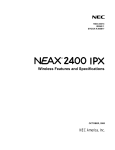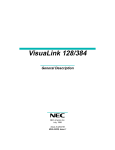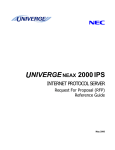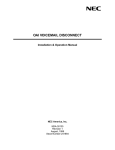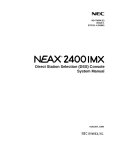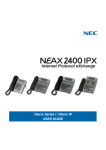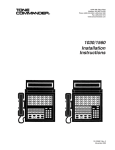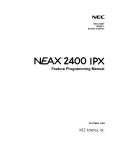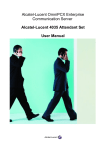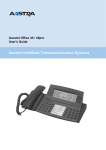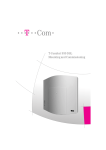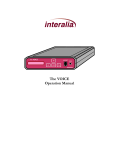Download Dterm Series E Agent Console User Guide
Transcript
DTERM ® SERIES E Agent Console USER GUIDE LIABILITY DISCLAIMER NEC AMERICA, INC. RESERVES THE RIGHT TO CHANGE THE SPECIFICATIONS, FUNCTIONS, OR FEATURES, AT ANY TIME, WITHOUT NOTICE. NEC AMERICA, INC. HAS PREPARED THIS DOCUMENT FOR USE BY ITS EMPLOYEES AND CUSTOMERS. THE INFORMATION CONTAINED HEREIN IS THE PROPERTY OF NEC AMERICA, INC. AND SHALL NOT BE REPRODUCED WITHOUT PRIOR WRITTEN APPROVAL FROM NEC AMERICA, INC. COPYRIGHT 1998 NEC AMERICA, INC. TABLE OF CONTENTS DEDICATED FUNCTION KEYS AND LAMPS TO LOG ON WHEN ID CODE IS REQUIRED TO LOG ON WHEN ID CODE IS NOT REQUIRED TO LOG OFF WITH OR WITHOUT ID CODES TO SET AUTOMATIC ANSWER TO SET MANUAL ANSWER TO ANSWER/RELEASE AN INCOMING ACD CALL TO HOLD A CALL TO TRANSFER A CALL TO SPLIT QUEUE TO SET/RESET BREAK MODE WORK MODE DURING A CALL TALLY COUNT TO PLACE AN ASSISTANCE CALL MONITOR ME TO PLACE AN EMERGENCY CALL TO REPORT TRUNK TROUBLE TALLY-OH FEATURES TO ORIGINATE AN OUTSIDE CALL TO ORIGINATE AN INTERNAL CALL TO ORIGINATE A CALL USING SPEED CALLING ACCOUNT CODE FORCED ACCOUNT CODE AUTHORIZATION CODE 2 7 8 9 10 11 11 13 14 15 17 18 18 19 20 21 21 27 27 28 29 30 30 CONFERENCE TO ESTABLISH A BROKER CALL TO ANSWER A CAMPED-ON CALL CALL WAITING – ORIGINATING CALL PARK CALL PICK-UP ( GROUP ) CALL PICK-UP ( DIRECT ) OUTGOING TRUNK QUEUING OFF-HOOK TRUNK QUEUING LAST NUMBER REDIAL CALL FORWARDING – ALL CALLS CALL BACK TO SAVE AND REPEAT A NUMBER TO LEAVE A MESSAGE TO ANSWER A MESSAGE DO NOT DISTURB PRIVACY DATA FEATURES TO ESTABLISH EXTERNAL DATA TRANSMISSION VIA MODEM POOLING This user guide is published to support Dterm Series E ACD Terminal operation with ACD Release II, III, IV (NEAX2400 IMS) and CallCenterWorX (NEAX2000 IVS). 31 32 32 33 34 36 36 37 38 38 39 40 41 42 42 43 44 44 46 DEDICATED FUNCTION KEYS AND LAMPS LOGON Press to LOGON or LOGOFF status. BREAK When pressed by the ACD Agent, the position is still Logged On, but it is temporarily unavailable to receive ACD calls. (This key is used for lunch time and breaks, etc) FUNCTION KEYS RELEASE Press this key to release an established ACD or NON-ACD call. TRANSFER Used to set or reset Work mode. Allows the console user to transfer established calls to another station, agent or queue without attendant assistance. HOLD CONF Used to hold an ACD call or a NON-ACD call presently in progress. Allows simple access to establish a three-way conference. DIAL KEY PAD TALLY Provides access to NON-ACD PBX dialed features and input of Tally Count data to the MIS system. By pressing this key an Agent enters the tally count mode. The Agent can register up to 22 digits by pressing the dial pad digit x (x=1-9) and then #, for each different event. WORK 2 ACD PROGRAMMABLE LINE/FEATURE KEYS EMER This feature permits an ACD Agent to record a conversation between an ACD Agent and caller if recording equipment is provided. Simultaneously, a call is placed to the Split Supervisors Line key for silent monitoring. AUTO/MAN When pressed the associated lamp will light steadily indicating the Agent is in the Automatic Answer Mode and will automatically receive a new ACD call upon the release of an established call if calls are in queue to that Split. Before being connected to a new call the Agent will hear “Zip” tone. ACD CALL All ACD calls directed to an ACD Agent will terminate to this line key. LINE When pressed again the Agent’s Answer mode will change from Automatic to Manual. The associated lamp is dark. When an ACD call comes into the ACD Agent position which is set for manual operation, the console rings and must be manually answered by pressing the ACD call key. This key is used by the Agent to originate or answer a NON-ACD call. TRK TRBL The Agent presses this key to report low volume, static, or any problem with trunks encountered during a call.* MONITOR/BARGE *This feature does not improve upon problem encountered. This feature allows the Agent to select another Agent position to monitor or barge into calls on both the ACD line and NON-ACD line at that Agent position. 3 ASSIST NON-ACD PROGRAMMABLE LINE/FEATURE KEYS Feature activation provides immediate call connection to a split supervisor’s line key for assistance in handling a complaint or problem. NOTE: Each ACD Agent may program PBX features in any of the unused twenty-four programmable line keys or available one touch calling keys. CW This key is used to indicate calls in queue. The Agent presses this key to show how many calls in queue and the time of the longest waiting call. MSG Message Reminder – Dterm Series E station users may leave messages on the alphanumeric displays of other Dterm Series E instruments, indicating their station number and time of call attempt. FEATURE Used to adjust LCD contrast, speaker/receiver, volume, and ringer volume. RECALL UP/ DOWN Press to terminate established call and reseize internal dial tone. ◆ LCD Contrast: Press ▲ or▼ key while idle. PICK ◆ Speaker / Receiver Volume: Press ▲ or▼ key during conversation. Call Pick-Up-Group – this feature allows a station user to intercept calls directed to another station. ◆ Ringer Volume: Press ▲ or▼ key during ringing. 4 PICK-DIRECT DTX Call Pick-Up-Direct – allows a station user to intercept calls directed to another station. Press key to transfer a call from a voice line to a data line. FWD DND Call Forwarding-All Calls – this feature allows the station user to forward a split incoming call to an alternate answering position. Do not disturb – the feature allows a station user to stop calls from ringing at the station during on hook or off hook condition. DSY/AUTO CALL BACK While engaged in a voice conversation, the Agent presses this key to display the status of a data connection. If this key is pressed while not engaged in a data connection the agent sets the data terminal equipment to the Automatic Answer Mode. Enables an originated NON-ACD call upon encountering a busy condition to have a call automatically completed when the called ACD Agent or busy trunk becomes idle. NOTE: Lower line of LCD constantly indicates time, day and date. DATA NOTE: Display indicatations may change depending on the PBX product. Display in this manual reflect the indicates behind the NEAX2400 PBX. The Agent presses this key to set up a connection between the MIS system and the MIS terminals. 5 SOFT KEYS Help On Hook State (Telephone is idle) 3:17 PM Fri Mic Press the Help Key. Press desired Soft Key for helpful information about that key. 28 Exit Headset Help Exit Press the Exit Key to exit the Help program. OHROFF (Off Hook Ringing Off) 2000 Off Hook State (Telephone is in use) 3:17 PM Fri 28 OHROff MIC HSET MUTE Exit Go off-hook or press Speaker Key, then press Soft Key below “OHROFF” to disable ringing on secondary and trunk line appearances on this telephone while in use. Help Headset OHR-ON (Off Hook Ringing On) Press the Soft Key below “Headset” to activate Headset operation. The primary extension LED will illuminate when headset is on. Go off-hook or press Speaker Key, then press Soft Key below “OHR-ON” to allow ringing on secondary and trunk line appearances on this telephone while in use. Mic Press the Soft Key below “Mic” to activate or deactivate the Microphone. The Mic LED will illuminate when Mic is on. MUTE Go off-hook or press Speaker Key, then press Soft Key below “MUTE”. MUTE will flash and Voice Path is eliminated to the handset, headset or speaker. 6 TO LOG ON WHEN ID CODE IS REQUIRED ♦ Dial Agent LOG ID Code, press the # key, digits dialed are displayed. The LOGON and WORK lamps light steadily; display indicates greeting. If the entered Log On ID code is currently in use, the display indicates ID IN USE and then returns to LOGON ID? If an invalid ID code is entered, the display returns to LOGON ID? and the Agent must enter a current Log On ID. Then reviews the following modes: HELLO LARRY (Time display) SPLIT CUST. (Time display) From VACANT Status: ♦ LOGON lamp NOTE: Auto Answer is displayed and active only if auto answer is programmed. VACANT is dark. (Time display) ♦ Press LOGON key, LOGON key flashes. LOGON NOTE: Work mode is displayed and active only if work mode has been programmed. ID? (Time display) 7 WORK MODE (Time display) SYS. ♦ The WORK key must be pressed before Agent can begin taking calls. The console is now in Ready status. TO LOG ON WHEN ID CODE IS NOT REQUIRED READY (Time display) From VACANT Status: ♦ LOGON lamp VACANT is dark. (Time display) ♦ Press LOGON HELLO key, LOGON lamp is lit steadily; display indicates the greeting. Then reviews the following modes: LARRY (Time display) SPLIT SALES (Time display) 8 NOTE: Auto answer is displayed and active only if auto answer is programmed. NOTE: Work mode is displayed and active only if work mode has been programmed. ♦ The WORK key must be pressed before the Agent can begin taking calls. The console is now in Ready status. TO LOG OFF WITH OR WITHOUT ID CODES AUTO ANSWER (Time display) WORK MODE FROM BREAK MODE, WORK MODE OR READY STATUS (Time display) ♦ Press LOGON key, GOODBYE lamp is dark. Several displays will cycle on the display for 4 seconds each, ending with farewell greeting. READY (Time display) LARRY (Time display) NOTE: Name will only be displayed if LOGON ID codes are used. During LOGOFF, ACD calls cannot be received. ♦ The time since LOGON in hours, minutes and seconds. 9 SHIFT 6:38:08 (Time display) ♦ The number of ACD CALLS incoming calls handled. ♦ Of the calls handled, (Time display) AVG TALK the average time spent on each call in minutes, seconds and tenths of a second. ♦ The cumulative amount of time spent in Break Mode during the shift in hours, minutes and seconds. ♦ Finally, the display 1:30.9 NOTE: This feature applies only to a station that is off hook on handset or headset. (Time display) NOTE: Automatic Answer applies only to ACD calls. It does not apply to calls terminated on the agent line key. T-WORK amount of time spent in Work mode during the shift in hours, minutes and seconds. ♦ The cumulative TO SET AUTOMATIC ANSWER 138 2:07:41 FROM MANUAL ANSWER STATUS (Time display) ♦ Press AUTO key. AUTO ANSWER (Time display) T-BREAK 1:02:41 ♦ Lamp lights steadily. (Time display) ♦ Incoming, ACD calls are answered automatically. “Time in Q: X:XX” is displayed temporarily. ♦ Zip tone is heard VACANT shows VACANT. before call is connected to ACD Agent. (Time display) 10 Elapsed Time Type No. 15:39 WATS 3 (Time display) TO SET MANUAL ANSWER TO ANSWER/RELEASE AN INCOMING ACD CALL FROM AUTOMATIC ANSWER STATUS FROM THE MANUAL ANSWER STATUS ♦ Press AUTO key. ♦ Incoming ACD MANUAL ANSWER (Time display) ♦ Lamp is dark. key or go off hook on the ACD line to answer calls. (Time display) Display alternates between who is calling name, ACD Agent number, trunk etc. and time in queue in minutes and seconds. ♦ Incoming ACD calls. ♦ Press ACD CALL READY call, associated lamp flashes red. Time Type No. 15:39 WATS 3 ♦ Press ACD CALL 15:39 key or go off hook on the ACD line, lamp is steadily lit green. (Time display) ♦ Upon completion of conversation, press RELEASE key if using handset, position is returned to Ready Status. WATS (Time display) TIME IN Q (Time display) 11 3 0:02 ♦ Upon completion 15:39 of conversation, press RELEASE key. ♦ Zip tone is heard before call is connected to SERVICE the agent. (Time display) ♦ Upon completion ♦ Position is returned of call, press RELEASE key. READY to Ready Status, agent position is available for the next call in queue. SERVICE (Time display) (Time display) ♦ Position is returned to Ready Status, agent position is available for the next call in queue. NOTE: Automatic Answer applies only when the Agent is in the off-hook condition. FROM AUTOMATIC ANSWER STATUS ♦ Incoming ACD call, 15:39 15:39 hear zip tone, lamp lights green, name displayed. SERVICE (Time display) TIME IN Q 0:04 (Time display) 12 TO HOLD A CALL IF UNANSWERED ♦ After a preprogrammed time; automatic recall is initiated. WHILE ENGAGED IN AN ACD CALL ♦ Press HOLD key; HLD held line will flash green. WATS ♦ Visual and audible signal (rapid flash and ring burst) will be sent to ACD Agent which placed call on hold. 3 (Time display) ♦ Displayed name, ACD Agent number, trunk, etc. flashes. TO RETRIEVE ♦ Lift Handset. ♦ Press ACD key. 1:09 Route TRK No. WATS 3 (Time display) ♦ Upon call completion press RELEASE key. READY (Time display) 13 TO TRANSFER A CALL TO SPLIT QUEUE ♦ Dial the destination split via a pilot number. XFR 3000 (Time display) will be heard by the transferred party) or wait for transfer ACD agent to answer. After pressing the TRANSFER key, the PBX station or ACD agent or supervisor position transfers the calling party to the ACD pilot by dialing the pilot number associated with the split the call is being transferred to. receive interrupted dial tone. Flashes ♦ Press RELEASE key, hang up (announcements FROM A PBX STATION OR AN ACD AGENT OR SUPERVISOR POSITION ♦ Press TRANSFER key, Steady XFR (Time display) NOTE: ACD calls transferred to a NON-ACD transfer station will recall if the station is busy upon release. 14 FROM READY STATUS USING A NORMAL BREAK TYPE TO SET/RESET BREAK MODE ♦ Press BREAK key, ON BREAK lamp lights steadily. (Time display) WHILE ENGAGED IN AN ACD CALL ♦ Press BREAK key, lamp lights steadily. TO RESET BREAK PENDING ♦ Upon completion of Break mode, press BREAK key. Lamp lights steadily. (Time display) Then changes to: WATS 3 BREAK OVER 15:00 (Time display) Then changes to: ♦ Break mode is canceled (Time display) and the LCD display indicates time spent on break in minutes and seconds. ♦ Position in the Break mode upon completion of the conversation, will be taken out of queue and no ACD calls will be routed to the position. READY (Time display) NOTE: Break mode can be set if any call is on hold. Break Mode may be set/reset when NON-ACD LINE is actively engaged in a call. 15 ♦ Status returned to Ready or Work mode. NOTE: The Supervisor defines Break selection types in the MIS and provides this information to the Agent. NOTE: Depending on the type of MIS system used, the ACD system can be set up for multiple break type. ♦ Multiple break types is selected by the system. Press the BREAK key, lamp lights steadily. ♦ The agent then inputs x via the key pad, one digit (x=x1-9), then presses the # key. Example: Break 1 - Lunch Break 2 - Restroom Break 3 - Files Break 4 - Coffee BREAK TYPE? (Time display) BREAK TYPE? (Time display) BREAK TYPE = X (Time display) Then changes to: ON BREAK (Time display) 16 ♦ No further ACD calls will be received. WORK MODE DURING A CALL ♦ Upon completion of Work, press WORK key, lamp extinguishes. TO SET WORK MODE DURING A CALL Ready, ACD calls will be received. key, WORK lamp lights steadily. WORK PENDING (Time display) ♦ Press RELEASE key or go on hook to terminate ACD call. (Time display) ♦ Work mode is canceled, status returns to ♦ While engaged in an ACD call, press WORK ♦ Displays Work Pending. READY WORK MODE (Time display) Then changes to: ♦ Work lamp light steady red. (Time display) 17 TALLY COUNT TO PLACE AN ASSISTANCE CALL WHILE ENGAGED IN AN ACD CALL OR IN WORK MODE ♦ Press TALLY key; AGENT IS ENGAGED IN AN ACD CALL TALLY NUMBER? ♦ Agent presses lamp flashes green. ASSIST key; lamp lights steadily. (Time display) ♦ Press desired digit 1-9 key on dial keypad up to 22 digits, press # key to validate entry. The entered digits are displayed. ASSIST PARTS (Time display) ♦ The Agent hears ring back tone and the assist 22# destination is rung (normally a supervisor). If no supervisor is available, the call waiting indicator is provided to each supervisor, until answered. (Depends on ACD programming). (Time display) ♦ Agent may converse with supervisor, ACD Then changes to: Call is held in automatic hold mode. TALLY ENTERED ♦ To cancel assistance call, press the TRANSFER key; the ACD will be recovered. (Time display) ♦ TALLY lamp extinguishes. ♦ Data is registered in the MIS system. 18 MONITOR ME CALL CONFERENCE/TRANSFER ♦ Upon completion of conversation, press CONF key, all three parties will be connected. ♦ An agent can request to be monitored by a specific agent or supervisor. If the ASSIST key feature is dedicated to the MONITOR ME feature. ♦ Either the Supervisor or the Agent may drop out of the call by pressing RELEASE key. When the agent or supervisor disconnects from the assisted call, the ASSIST lamp extinguishes and the display returns to the original status. ♦ Press the ASSIST ♦ The remaining party may converse with the is terminated to a busy supervisor. ASSIST BUSY (Time display) Either the supervisor’s name or the name of the supervisor’s split is displayed. ACD caller. ♦ If the assist feature MONITOR JAMES key. The ASSIST lamp lights. XXXX ♦ When the supervisor answers. (Time display) MONITOR XXXX (Time display) ♦ The ASSIST lamp TO CANCEL flashes red at the ACD Agent. ♦ Press TRANSFER key to return to the calling ♦ The monitor lamp flashes red at the supervisor party, the assistance call is canceled. position. ♦ To barge into the call, the supervisor presses the MON key, then 1, #. 19 ♦ If the supervisor decides to join the call, the ♦ To barge into the call the supervisor presses the MON key, then 1, #. agent and calling party will hear a warning tone. ♦ Press RELEASE key to transfer the call to TO PLACE AN EMERGENCY CALL supervisory position after the supervisor answers. No dialing is necessary. ♦ To cancel emergency request (to ringing destination), press the EMER key again. AGENT CONSOLE IS AN ACD CALL ♦ Agent presses EMER key, lamp lights red steadily. ♦ Supervisor is monitoring call between Agent and ACD caller. ENGAGED IN EMERG TO BUSY DESTINATION ♦ If the request is routed to an individual SUPVR supervisor’s ACD or PBX line, press the EMER key. (Time display) MONITOR ♦ If the request is XXXX routed to a busy supervisor, the agent’s LED is extinguished. (Time display) EMERG BUSY (Time display) ♦ ASSOCIATED lamp will flash. ♦ The ACD agent’s conversation is ♦ Conversation is simultaneously being never interrupted. recorded if equipment has been provided. 20 TO REPORT TRUNK TROUBLE TALLY-OH FEATURES ♦ Tally-Oh codes beginning with a zero are reserved for special use by agents and are not reported to the MIS. These codes invoke various actions, such as statistical displays and mode changes performed on a tenant basis. NOTE: The ACD call is not effected by this procedure. ACD Agent must be engaged in a call to initiate a trunk trouble report. Pressing TRK TRBL key does not clear the problem. Trunk trouble can only be activated while on an ACD call (station or trunk call). ♦ While engaged OPERATING PROCEDURES ♦ Press TALLY key. TROUBLE REPORTED in an ACD call, press TRK TRBL key once only. ♦ Enter tally code, then #. (Time display) When changes to: after 4 seconds: 5:22 WATS 3 (Time display) ♦ Trouble report is automatically reported to MIS subsystems and Maintenance Administration Terminal. 21 Special Agent System Tally Code (Leading O) Code Meaning 000# Displays the agent’s statistics (shift time, number of ACD calls answered, average talk time, total time in Work mode since logging on, and total time in Break mode since logging on) for the current agent or the last agent logged on. The statistics are for the shift, they are not given on a per split basis. To invoke, press 000#. SAMPLE DISPLAYS: SHIFT 3:12:48 (hours, minutes, seconds) ACD CALLS 22 (one to three digits) AVG TALK 3:11 (minutes and seconds) T-WORK 0:20:16 (hours, minutes, seconds) T-BREAK 0:10:00 (hours, minutes, seconds) 001# Displays the queue depth of the split(s) served by the logged on agent. If the position is Vacant and allowed a single split, the queue depth for that split is shown. For an agent, in multi-split mode, the information for each split will be displayed for a four second interval. To invoke, press 001#. SAMPLE DISPLAY: ORDERS 10 002# Displays the time waited by the longest waiting call in the split(s) served by the logged on agent. If the position is Vacant and allowed a single split, the wait time for that split is shown. For an agent, in multi-split mode, the information for each split will be displayed for a four second interval. To invoke, press 002#. SAMPLE DISPLAY: SERVICE 1:28 (Minutes, Seconds) 22 Special Agent System Tally Code (Leading O) Code Meaning 003# Displays the quantity of working agents (on an ACD call, in Work mode, in Ready mode) in the split(s) served by the logged-on agent. If the position is Vacant and allowed a single split, the quantity of working agents in that split is shown. For an agent, in multi-split mode, the information for each split will be displayed for a four second interval. To invoke, press 003#. SAMPLE DISPLAY: SERVICE 26 004# Displays the quantity of agents in Break mode in the split(s) saved by the logged on agent. If the position is Vacant and allowed a single split, the quantity of agents in Break mode in that split is shown. For an agent, in multi-split mode, the information for each split will be displayed for a four second interval. To invoke, press 004#. SAMPLE DISPLAY: DELIVERY 6 005# Displays the elapsed time since entering the current mode. The code is valid for the following modes: on an ACD call, Work mode, Break mode, Ready mode. To invoke, press 005#. SAMPLE DISPLAY: BREAK 0:10:00 (hours, minutes, seconds) 23 Special Agent System Tally Code (Leading O) Code 006# Meaning Sends a request during an ACD call for a supervisor to monitor the conversation. The display shows the designated supervisor’s name or split. To invoke, press 006#. SAMPLE DISPLAY: MONITOR JAMES 007# Sends a request to temporarily disable the Work mode time limit. This request is only valid from Work mode, and the timer will be disabled only until the agent leaves Work mode. To invoke, press 007#. SAMPLE DISPLAY: TIMEOUT DISABLED 008# Displays the time and date for four seconds. This request can be made from any mode. To invoke, press 008#. SAMPLE DISPLAY: 1:32 PM MON 22 009# Clear permanent display such as ”READY,” “ON BREAK,” or “VACANT.” 021# Setup Connection Displays, see “CONNECTION DISPLAYS C-199” see ACD F&S. 022# Online Help, see “CONNECTION DISPLAYS C-199” see ACD F&S. 023# Show Connection Displays, see “CONNECTION DISPLAYS C-199” see ACD F&S. 24 Special Agent System Tally Code (Leading O) Code Meaning 024 To add a new split to split list. To invoke, press 024ssspp# to add a new working split (sss) at preference level (pp) to the list of working splits. An agent may work in up to 16 splits simultaneously. 025 To delete a split from the split list. To invoke, press 025sss# to delete a split (sss) from the list of splits. 026# To display current split list. To invoke, press 026# to display a list of the currently assigned splits on the agent’s LCD display. Each split’s name will be shown for approximately 3 seconds. 027# To save the current working split list to permanent ACD database memory. To invoke, press 027# to save the current split assignments to permanent ACD database memory. Ordinarily, when splits are added or deleted (via Tally-Oh 024 and 025) they are in use for the current logon session only. However, if the split selections are to be permanently assigned (until modified) to that agent’s logon ID then they must be transferred to permanent ACD database memory. 028# Unlocks the agent’s current position. This request is for emergency use only. There is no display associated with this request. To invoke, press 028#. (Emergency use only, notify NECAM of any lockups.) 25 Special Agent System Tally Code (Leading O) Code 029# Meaning Forces the agent to log off at the current position. This request is for emergency use only. There is no display associated with this request. To invoke, press 029#. (Emergency use only, notify NECAM of any lockups.) 26 In this section, additional Function Keys (e.g. FEATURE, ANSWER, TRANSFER, etc.) must first be programmed on the Agent Console by the System Administrator. TO ORIGINATE AN INTERNAL CALL TO ORIGINATE AN OUTSIDE CALL ♦ Lift handset or headset. ♦ Press NON-ACD LINE key. ♦ Receive dial tone. ♦ Dial desired station number; display indicates ♦ Lift handset or headset. digits dialed. ♦ Press NON-ACD LINE key. ♦ Use handset to converse. ♦ Receive dial tone, Dial the Central Office Access Code, e.g. 9. ♦ Dial desired telephone number. ♦ Use handset to converse. Elapsed Time TRK Type TRK No. 15:39 WATS 3 (Time display) Time Day Date 27 TO VERIFY TO ORIGINATE A CALL USING SPEED CALLING (ONE-TOUCH KEYS) ♦ Press FEATURE key. ♦ Press desired SPEED CALL key. ♦ Display indicates digits programmed. ♦ Press NON-ACD LINE key. NOTE 1: To program a hookswitch for transfer or feature activation, press RELEASE key as first digit (“!” displays on LCD). NOTE 2: To program a pause, press RELEASE key as any digit other than the first (“-” displays on LCD). NOTE 3: To program a Voice Call press TRANSFER key after dialing station number (“V” displays on LCD). NOTE 4: Speed calling for feature access: Speed call keys may be used as feature keys by storing the NEAX2400 feature access codes. The feature may be programmed on a system basis by the PBX engineer. Access codes may be stored in conjunction with telephone numbers. For example, one button can be programmed by the user to transfer to a cetain extension. ♦ Press desired SPEED CALL key, or press SPKR and SPEED CALL. TO PROGRAM (Available only on Dterm stations with speed calling keys). ♦ Press FEATURE key. ♦ Press desired SPEED CALL key. ♦ Enter desired telephone number or feature code on the keypad. Display indicates digits dialed. SPD SET (Time display) 28 ACCOUNT CODE TO ENTER ACCOUNT CODE AFTER AUTHORIZATION CODE ♦ Life handset. TO ENTER ♦ Press NON-ACD LINE key. ♦ Lift handset. ♦ Receive dial tone. ♦ Press NON-ACD LINE key. ♦ Enter feature Access Code for Authorization ♦ Receive dial tone. Code, receive Service Set tone. ♦ Enter feature Access Code, receive Service NOTE: Authorization and account codes may be up to 15 digits combined. Set tone.* ♦ Enter Account Code (up to 10 digits). ♦ Enter Authorization Code, receive second Service Set tone.* ♦ Receive Dial Tone and dial desired number. ♦ Enter Account Code, receive dial tone and dial desired number. *Service Set tone is optional depending upon system programming. 29 FORCED ACCOUNT CODE AUTHORIZATION CODE TO ENTER WITHOUT ACCOUNT CODE ♦ Lift handset. ♦ Lift handset. ♦ Press NON-ACD LINE key. ♦ Press NON-ACD LINE key. ♦ Receive dial tone. ♦ Receive dial tone. ♦ Enter feature Access Code, receive Service ♦ Enter feature Access Code, receive Service Set tone.* Set tone.* ♦ Enter Forced Account Code (up to 10 digits), ♦ Enter Authorization Code (up to 10 digits), receive dial tone. receive second service set tone. ♦ Dial desired number. ♦ Receive dial tone, dial desired number. *Service Set tone is optional depending upon system programming. *Service Set tone is optional depending upon system programming. 30 –OR– CONFERENCE ♦ Press NON-ACD LINE key. ♦ Receive dial tone. ♦ With call in progress, ask party to hold. ♦ Dial desired number. ♦ Press TRANSFER key, receive interrupted dial tone. ♦ If Authorization Code is required, caller hears ♦ Dial desired number. special dial tone. ♦ After call is answered, press CONF key; ♦ Enter Authorization Code, or call will be denied. CONF LED lights. ♦ Three-way conference is established. CNF (Time display) ♦ If one party hangs up, other two remain connected; CONF LED goes out. 31 TO ESTABLISH A BROKER CALL TO ANSWER A CAMPED-ON CALL ♦ While engaged in a call and wishing to consult FROM THE ATTENDANT a third party, press TRANSFER key; receive interrupted dial tone, caller is automatically placed on hold. ♦ While engaged in a call, receive camp-on indication (one short tone burst); the ANSWER LED will flash. ♦ Dial desired party to consult. ♦ Press ANSWER key; call in progress is placed ♦ Press TRANSFER key to return to original on hold. caller. Third party is automatically placed on hold. ♦ Connection to camped-on call is established. ♦ By repeating these steps, it is possible to ♦ By repeating these steps, it is possible to alternate between calls. alternate between calls. NOTE: Display will indicate connected station or trunk at any given time. NOTE: Display will indicate connected station or trunk at any given time. TRK Type TRK No. ♦ Press ANSWER key to return to original call, camp-on call is placed on Hold. 32 CMP WATS 1 CALL WAITING – ORIGINATING TO ACTIVATE CALL WAITING – ORIGINATING ♦ Dial desired station number, receive busy tone. ♦ Press CALL WAITING key. Called Station Number TO PROGRAM CALL WAITING KEY (ON ONE-TOUCH SPEED KEY) ♦ Receive special ring back tone, Call Waiting tone will be sent to busy station. ♦ Press FEATURE key. ♦ Press desired ONE-TOUCH SPEED key. ♦ Press RECALL key (“!” will appear on LCD).* – OR – ♦ Dial call waiting feature access code. ♦ Lift handset. ♦ Repress FEATURE key. ♦ Dial Call Waiting (Time display) CW access code, receive dial tone. *To program a hook switch for transfer or feature activation, press RELEASE key as first digit (“!” will be displayed on LCD). ♦ Dial busy station. /0 CW (Time display) CW SET 2000 (Time display) 33 CALL PARK TO ANSWER A CALL WAITING ♦ Call Waiting tone is heard. Calling Station Number CW SET 2000 TO PROGRAM CALL PARK KEY (ON ONE-TOUCH SPEED KEY) (Time display) ♦ Press ANSWER key. ♦ Press FEATURE key. NOTE: By pressing the ANSWER key, station can alternate between the original and camped-on parties, display will indicate connected station or trunk at any given time. ♦ Press one touch speed key. ♦ Press RECALL key (“!” will appear on LCD.) ♦ Call Waiting-Originating call is automatically ♦ Dial Call Park Access Code. connected; original party is placed on hold. ♦ Press FEATURE again. TO DISCONNECT PRK SET (Time display) ♦ Press RECALL key, station user will automatically be connected to original party. 34 TO PARK A CALL ON A NON-ACD LINE KEY TO RETRIEVE A PARKED CALL FROM A REMOTE STATION While connected to a station or trunk: ♦ Dial Call Park ♦ Press TRANSFER key. remote retrieval code* and the station number against which the call was parked. Parked Station or Trunk ♦ Dial the Call Park SET PARK Access Code or press the CALL PARK key. WATS 2 (Time display) Or, while connected to a station or trunk on a NON-ACD LINE key: ♦ Press one touch key or ♦ Dial Call Park local retrieval code. connected to parked call. WATS 10:01 WATS 3 (Time display) 200 is the station the call was parked from, WATS3 is the parked station or trunk. ♦ Station user is connected to parked call. TO RETRIEVE A PARKED CALL FROM AN ORIGINATING STATION ♦ Station user is 0:01 2 (Time display) Elapsed Time 35 CALL PICK-UP (GROUP) CALL PICK-UP (DIRECT) STATION WITHIN PICK-UP GROUP RINGS TO PROGRAM PICK-DIRECT KEY (ON ONE-TOUCH SPEED KEY) ♦ Lift handset. ♦ Press FEATURE key. ♦ Press NON-ACD LINE key. ♦ Press ONE-TOUCH SPEED key. ♦ Press CALL PICK-UP feature button or dial CALL PICK-Up Access Code. (Also, may be stored on one touch speed calling key.) ♦ Connection to calling party is established. PCK 2000 ♦ Dial Direct Call Pick-Up Access Code. ♦ Re-press FEATURE key again. WATS 3 A STATION WITHIN THE SYSTEM RINGS (Time display) Called Station ♦ Lift handset, receive dial tone. Calling Station ♦ Press PICK-DIRECT key and dial the station number to be picked up. ♦ If engaged on call on NON-ACD LINE key, press TRANSFER key and dial Call Pick-Up Access Code. The original party will be placed on hold. 36 OUTGOING TRUNK QUEUING – OR – ♦ Dial DIRECT CALL PICK-UP Access Code and the station number to be picked up. ♦ Connection to calling party is established. – OR – PCK 2000 If trunk “Busy”: WATS 3 ♦ Receive TRUNK (Time display) Called Station OGQ SET BUSY indication; press CALL BACK key. Calling Station (Time display) Call is placed in queue for next available trunk. ♦ Press programmed ONE-TOUCH SPEED key. ♦ When trunk is available, setting station is ♦ If busy, original call must be placed on hold alerted by ringing and flashing red LED. before new call can be picked up. ♦ Lift handset or headset. ♦ Press NON-ACD LINE key. ♦ Dial tone is heard or number is automatically dialed if NEAX2400 IMS is programmed with Least Cost Routing. 37 OFF-HOOK TRUNK QUEUING LAST NUMBER REDIAL ♦ Lift handset. TO RECALL THE LAST TELEPHONE NUMBER DIALED ♦ Press NON-ACD LINE key. ♦ Lift handset. ♦ Receive dial tone. ♦ Press NON-ACD LINE key. ♦ Dial OFF-HOOK QUEUING access code. ♦ Receive dial tone. ♦ Dial desired telephone number; encounter ♦ Press REDIAL key, outside or internal station is automatically redialed,when party has answered, lift handset to converse. a trunk busy condition. ♦ Station user receives Service Set tone, and leaves speaker on. The desired number will automatically be dialed when a trunk becomes available. LNR [*]/SD [-] (Time display) To display last number dialed: ♦ While on hook, press REDIAL key. ♦ Display indicates digits stored. 38 CALL FORWARDING – ALL CALLS TO CANCEL ♦ Lift handset. ♦ Press NON-ACD LINE key. TO SET ♦ Receive dial tone. ♦ Lift handset. ♦ Press FWD key or dial Call Forward cancel code; receive Service Set tone*, FWD lamp goes out at your station. ♦ Press NON-ACD LINE key. ♦ Receive dial tone. ♦ Press LINE key; code; receive special dial tone. *Service Set tone is optional depending upon system programming. ♦ Dial destination station or external telephone number; receive Service Set tone.* ♦ FWD LED lights (at your station or at the Dterm of the subline station you are setting). ♦ Return to onhook condition, call forwarding all calls is set. FWD CNCL Call forward all calls canceled. ♦ Press FWD key or dial Call Forward access FWD SET (Time display) 39 CALL BACK ♦ Lift handset, then called party’s phone rings. IF CALLED STATION IS “BUSY” ♦ Press CALL BACK Calling Party ♦ Connection is established when called 2000 NOTE: Call Back may be programmed by the PBX Engineer on a Programmable Line/Feature key or by the user on a Speed Calling One-Touch key. (Time display) – OR – *Service Set tone is optional depending upon system programming. ♦ Press FLASH key** and enter CALL BACK ** FLASH key must be programmed on ONE-TOUCH SPEED call key. access code. become idle, calling party’s phone rings. Calling party would go off hook and hear ring back tone. The called station would then be ringing. 2000 party answers. CB SET key if; receive Service Set tone.* ♦ When both parties CB CB 2000 (Time display) Called Party 40 TO SAVE AND REPEAT A NUMBER TO VERIFY ♦ While idle, press S & R key, display indicates digits stored. TO SAVE TO REPEAT ♦ Lift handset. ♦ Lift handset. ♦ Press NON-ACD LINE key. ♦ Press NON-ACD LINE key. ♦ Dial desired telephone number. ♦ Press S & R key; Dterm Series E will automatically redial the programmed number. ♦ Press S & R key; dialed number is now stored. ♦ S & R key automatically canceled; LED goes out. ♦ S & R key LED lights. NOTE: If Save and Repeat number is busy or no answer is received, to save it again, press S & R key before going back on hook. – OR – ♦ Receive Internal Call. ♦ Press S & R. Number is stored in memory. ♦ S & R LED lights. 41 TO LEAVE A MESSAGE •If station is not equipped to receive messages, reorder tone is heard. ♦ Lift handset. ♦ Press NON-ACD LINE key. ♦ Dial desired station number; encounter a TO DISPLAY “No-Answer” or Busy condition. message is sent to called Dterm Series E. (Time display) TO ANSWER A MESSAGE ♦ Receive dial tone. ♦ Press MSG key; MSG RST ♦ MSG LED LIT; 2000 MSG SET MSG station is idle. (Time display) 2000 12:28PM (Time display) ♦ Press MSG key; display indicates time of Recipient Station message and station number leaving message; ♦ Called station MSG LED lights. ♦ Re-press MSG key again to display additional messages in order received. NOTE: •Up to four messages can be stored in Dterm Series E memory. If a fifth message is attempted, ring back tone is heard. MSG BUSY (Time display) 42 DO NOT DISTURB TO RESPOND ♦ While displaying desired message; lift handset and Press NON-ACD LINE key. WHILE IDLE (ON HOOK) ♦ Press MSG key; station which left message ♦ Press DND key*; will be automatically redialed. DND SET LED lights. (Time display) TO ERASE ♦ Message is erased. TO CANCEL MSG CNCL ♦ Press DND key; (Time display) DND CNCL LED goes out. (Time display) ♦ To erase a message without returning the call, press MSG key to display desired message. *DND key must be programmed by the PBX engineer on a programmable feature key. ♦ Dial # while message is displayed, message is erased. NOTE: If station which left message is busy, callback or MSG may be set. If station which left message does not answer, MSG may be set, thus notifying originating party that a message return was attempted. 43 PRIVACY DATA FEATURES WHILE OFF-HOOK TO ACTIVATE SIMULTANEOUS VOICE/DATA TRANSMISSION ♦ Press DND key, PRV SET ♦ To send data to LED flashes; Display indicates: (Time display) ♦ Privacy feature prevents interruptions for the duration of a call. TO CANCEL ♦ Data connection – OR – privacy feature is automatically canceled. DTE XXXX (Time display) ♦ Receiving station presses DATA key. ♦ Press DND; LED goes out. ♦ Replace handset; D the same station already involved in voice conversation, originating station presses DTX key. RDY D DTE XXXX is established. (Time display) ♦ Voice conversation can be terminated by either PRV CNCL station without affecting data connection. (Time display) 44 ♦ To disconnect from RLS DATA connection, either station can press DATA key. D DTE ♦ DATA connection XXXX (Time display) NOTE: If receiving station is programmed for Auto Answer, disregard this step. TO SEND DATA TO A STATION WHILE INVOLVED IN A VOICE CONVERSATION WITH ANOTHER STATION ♦ Originating station presses DATA key and dials the Data port number of the destination station. RLS D DTE RDY is established while voice conversation continues. Voice conversation can be disconnected without affecting DATA connection. ♦ To disconnect from DATA connection, either station can press DATA key at any time. XXXX (Time display) D DTE XXXX (Time display) RLS D DTE XXXX (Time display) TO SEND DATA TO AN INTERNAL STATION WHEN NO VOICE COMMUNICATION IS TAKING PLACE ♦ Receiving station presses DATA key. ♦ Originating station NOTE: If receiving station is programmed for Auto Answer, disregard this step. presses DATA key and dials receiving station’s data extension. 45 D DTE (Time display) XXXX ♦ Receiving station presses DATA key. RDY D DTE TO ESTABLISH EXTERNAL DATA TRANSMISSION VIA MODEM POOLING XXXX (Time display) ♦ Data is established. ♦ To disconnect from DATA call, either originating or receiving station can press DATA key. ♦ Released station’s display indicates: RLS D DTE ♦ Internal station user initiates a voice conversation to an external party. XXXX ♦ External party switches over from voice to modem, or modem carrier tone is heard immediately. (Time display) NOTE: If receiving station is programmed for Auto Answer, disregard this step. ♦ After hearing modem carrier tone, originating (internal) station presses DTX key. YYY RDY D XXXX (Time display) ♦ Originating station‘s DTX lamp lights and Service Set tone is heard, replace handset. ♦ Called data terminal answers. ♦ DATA connection is established. NOTE: If internal station is programmed for Auto Answer, disregard this step. 46 INTERNAL PARTY RECEIVES A DATA CALL ♦ Station‘s data D port will ring. Data lamp flashes. ♦ Press DATA XXXX (Time display) YYY RDY D XXXX key to answer. (Time display) NOTE: If receiving station is programmed for Auto Answer, disregard this step. *Service Set tone is optional depending upon system programming. ♦ Data connection is established. TO RELEASE FROM A MODEM CALL ♦ Press DATA key, LED goes out. 47 NOTES 48 PROGRAMMABLE KEYS Flexible Line / PROGRAMMABLE KEYS Feature Keys (Programmable by telephone system One-Touch Speed administrator) Dial / Feature Keys Call Indicator Lamp EXIT SOFT KEYS LCD HELP (4) (Programmable by user) LOGON RELEASE CONF (Conference) TALLY HOLD (Enter/Exit Break Mode) WORK > < MIC (Microphone) Lamp TRANSFER BREAK UP / DOWN ( (Volume/Contrast) ) NEAX and Dterm are registered trademarks of NEC Corporation For more information contact: NEC America, Inc. CNG 1555 Walnut Hill Lane, Irving Texas 75038-3796 1 800 TEAM NEC 590301 *590301* 7/98
























































